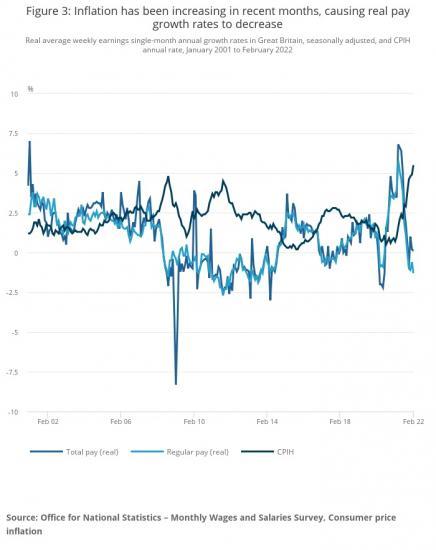Annual Pay Growth 5.4%
13th April 2022

Office for National Statistics report shows latest pay levels.
Main points for December 2021 to February 2022
Growth in average total pay (including bonuses) was 5.4%, and growth in regular pay (excluding bonuses) was 4.0% among employees in December 2021 to February 2022.
Previous months' strong growth rates were affected upwards by base and compositional effects; these initial temporary factors have worked their way out, but we are now comparing the latest period with a period where certain sectors had increasing numbers of employees on furlough as a result of the winter 2020 to 2021 lockdown, so a small amount of base effect will be present for these sectors but not to the degree we saw when comparing with periods at the start of the coronavirus (COVID-19) pandemic.
In real terms (adjusted for inflation) in December 2021 to February 2022, growth in total pay was 0.4% and regular pay fell on the year at negative 1.0%.
Strong bonus payments have kept real total pay growth positive, and, excluding, the coronavirus pandemic period, real regular pay growth last fell on the year to negative 1.0% in May to July 2014.
Average total pay growth for the private sector was 6.2% in December 2021 to February 2022, and for the public sector was 1.9% in the same time period; the finance and business services sector showed the largest growth rate (9.8%), partly because of strong bonus payments.
Private sector total pay growth was last higher than 6.2% in January to March 2007 when it was 6.5% (excluding the coronavirus pandemic period); public sector pay growth was last lower than 1.9% in July to September 2017 when it was 1.7%.
Average weekly earnings were estimated at £598 for total pay, and £556 for regular pay in February 2022.
The rate of annual pay growth for total pay was 5.4%, and the annual pay growth for regular pay was 4.0% in December 2021 to February 2022. Bonus payments since August 2021 have remained strong, especially in the finance and business services sector.
Previous months' strong growth rates were affected upwards by base and compositional effects. These initial temporary factors have worked their way out. However, we are comparing the latest period with a period where certain sectors (accommodation and food service activities, wholesale and retail, and construction) had increasing numbers of employees on furlough as a result of the winter 2020 to 2021 lockdown. A small amount of base effect will be present for these sectors but not to the degree we saw when comparing with periods at the start of the coronavirus pandemic.
Average total pay growth for the private sector was 6.2% in December 2021 to February 2022, while for the public sector it was 1.9%. Excluding the coronavirus (COVID-19) pandemic period, private sector total pay growth was last higher than 6.2% in January to March 2007 when it was 6.5%. Public sector pay growth was last lower than 1.9% in July to September 2017 when it was 1.7%.
In December 2021 to February 2022, the finance and business services sector had the largest growth rate (9.8%), partly because of strong bonus payments. Wholesaling, retailing, hotels and restaurants saw a growth rate of 6.4% in December 2021 to February 2022. This sector includes the industry accommodation and food, which had the highest proportion of employees on furlough during December 2020 to February 2021. Therefore, the growth rate of 12.0% for accommodation and food will be affected by base effect.
Read the full report at https://www.ons.gov.uk/employmentandlabourmarket/peopleinwork/employmentandemployeetypes/bulletins/averageweeklyearningsingreatbritain/april2022
